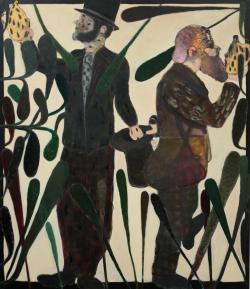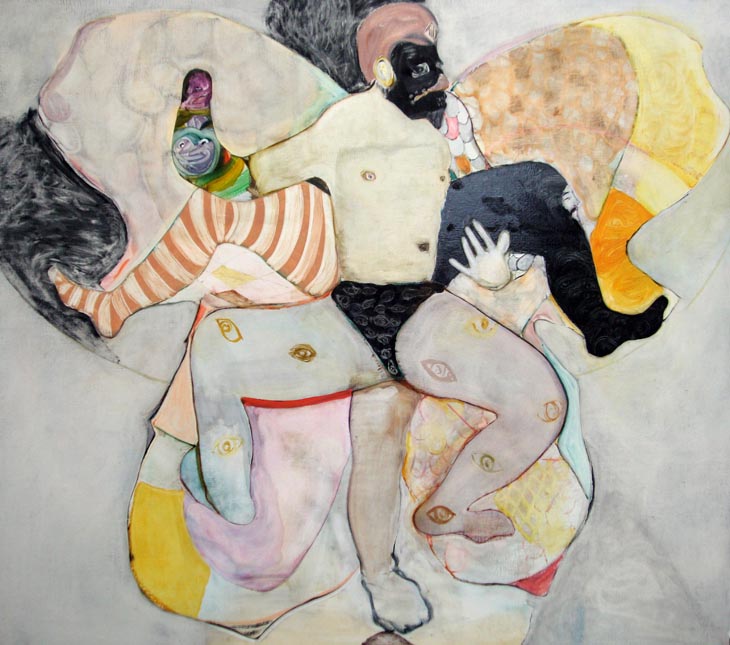
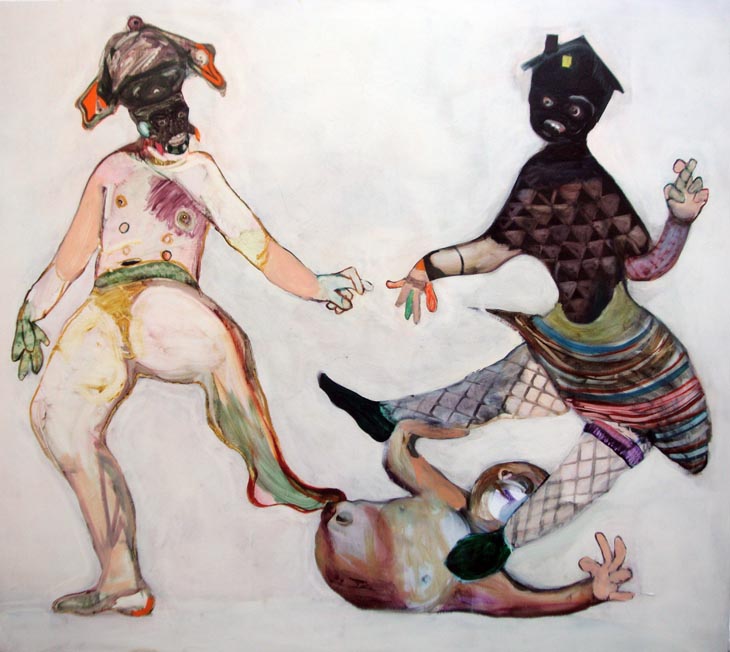
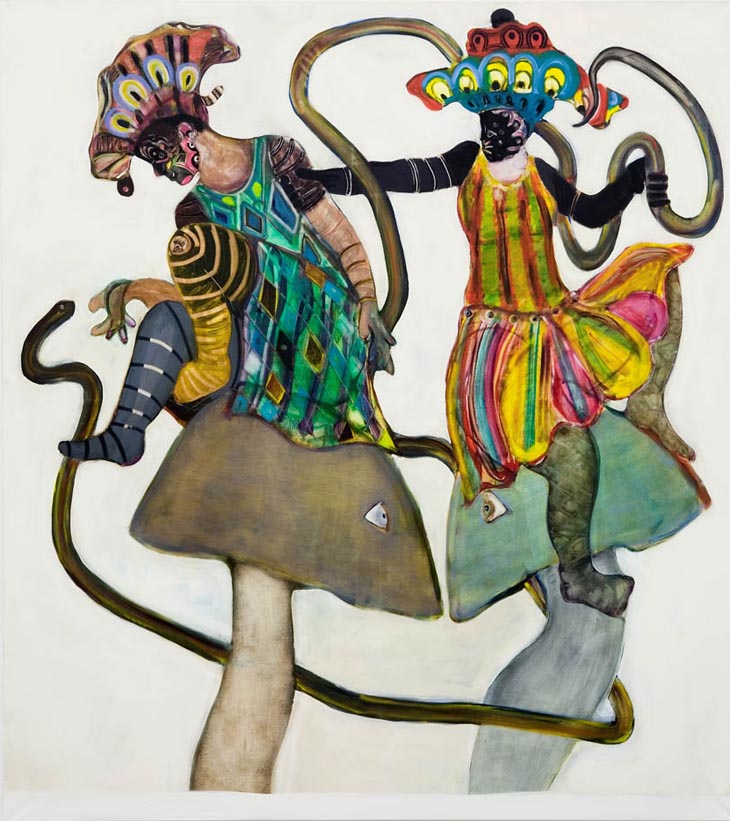
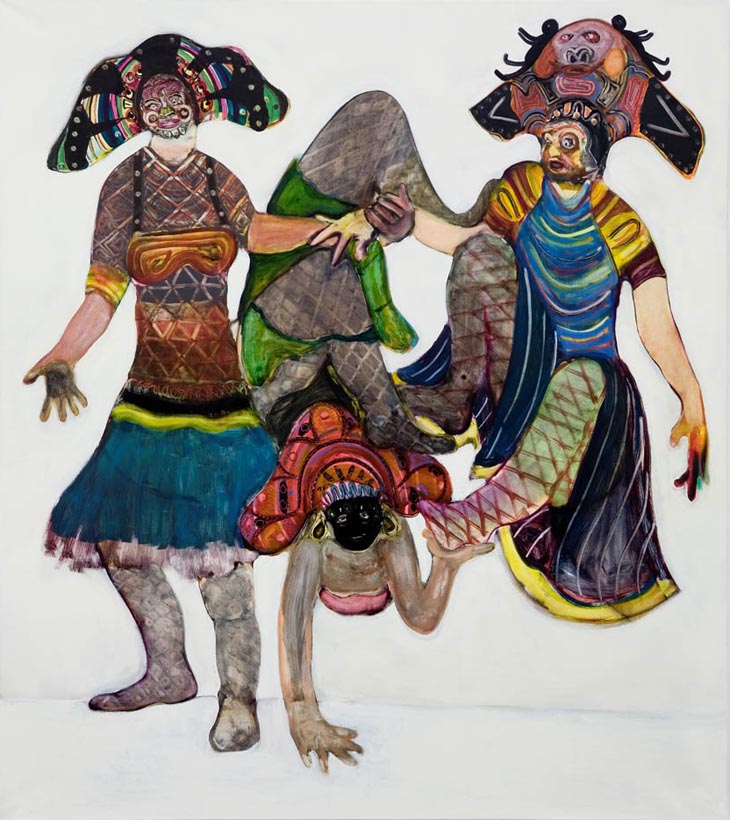
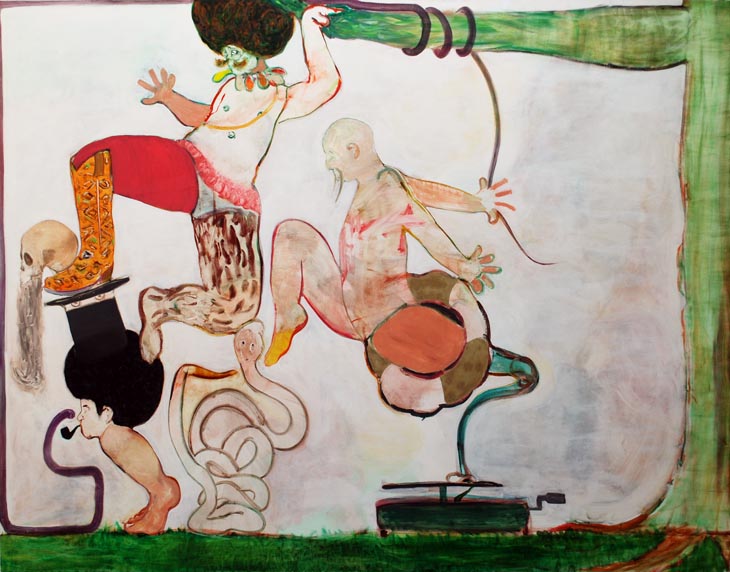
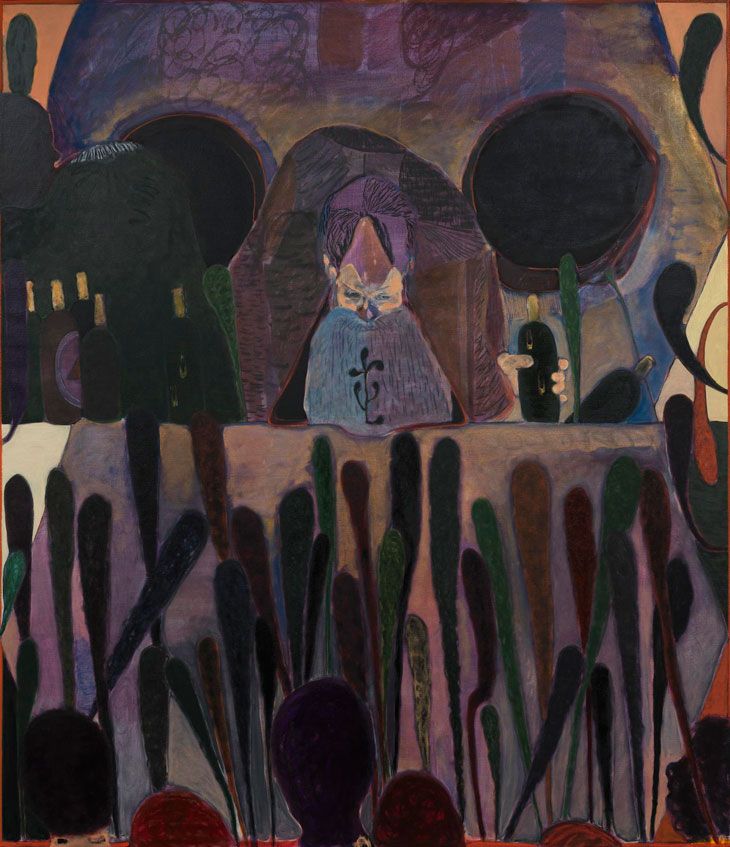
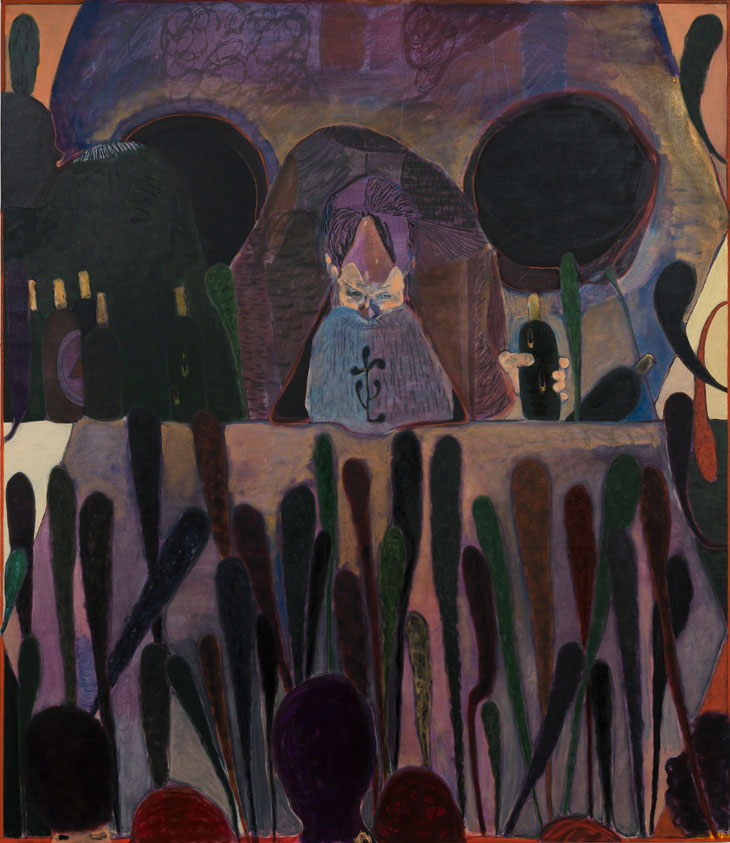
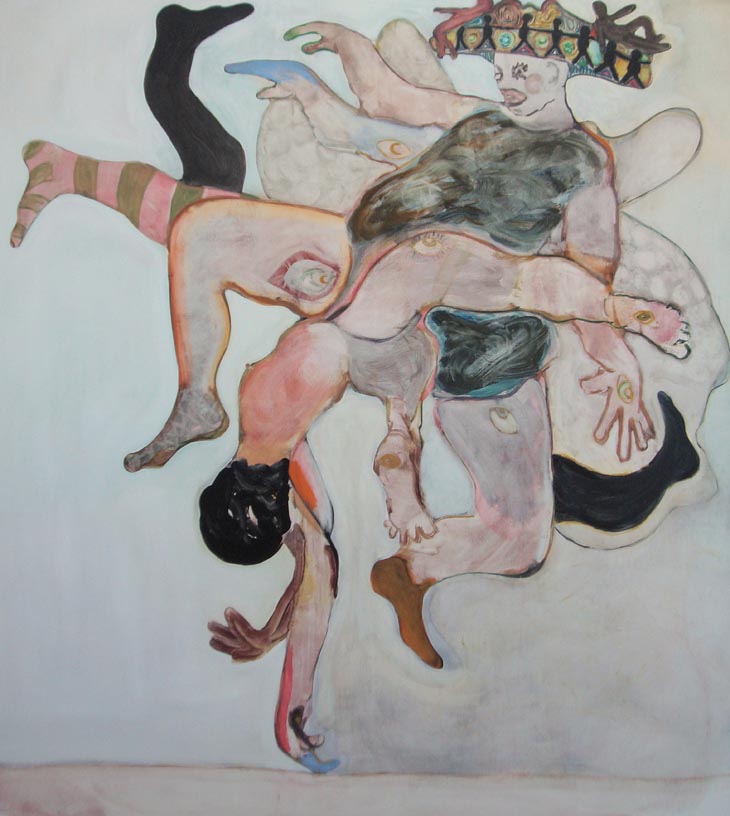
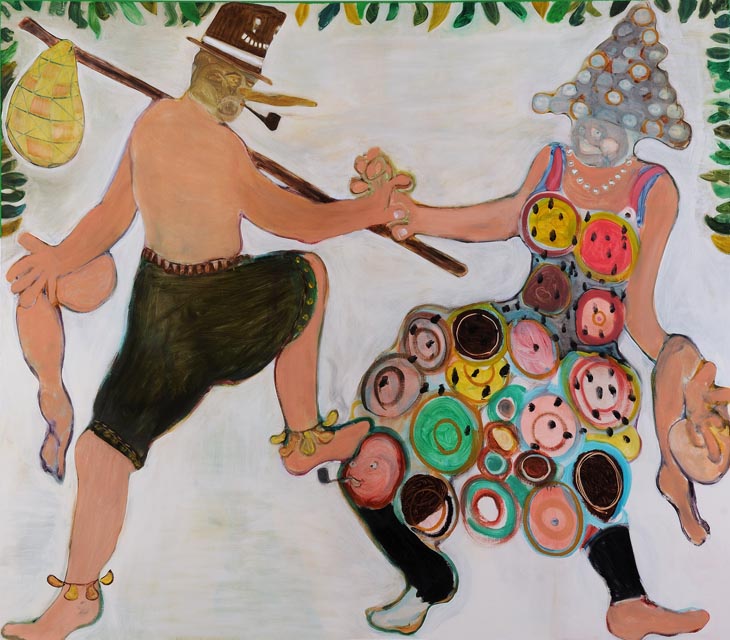

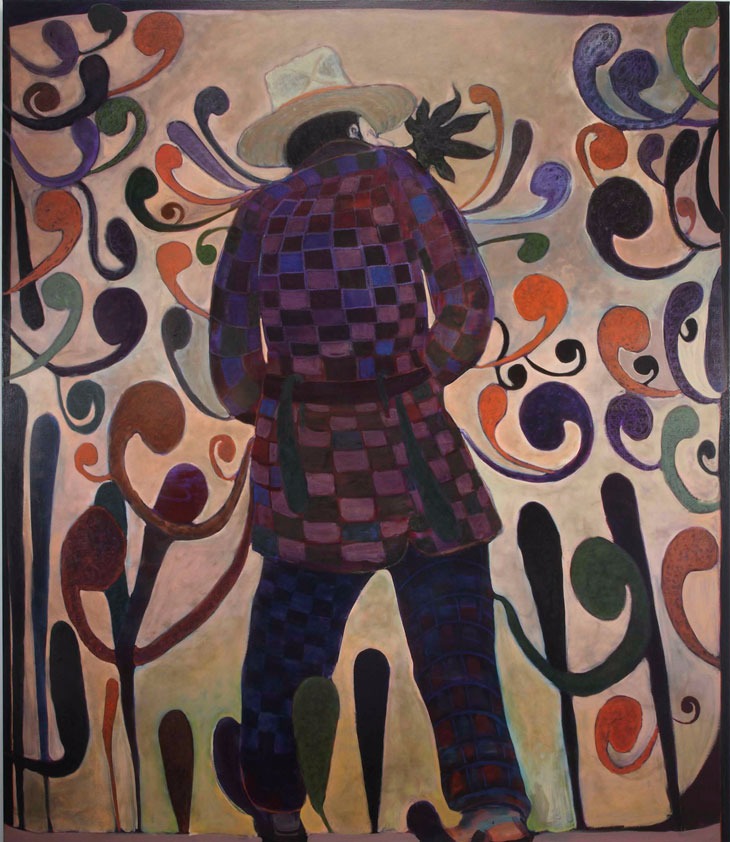
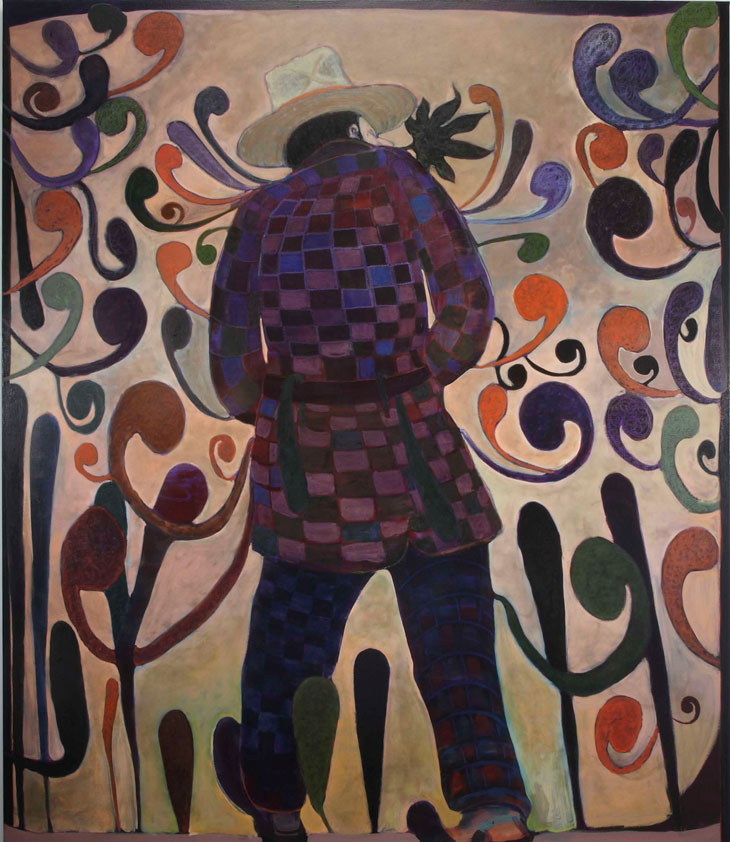
Ryan Mosley
Motivated by a sense of the carnivalesque, Ryan Mosley’s canvases offer up a surreal world of invented characters and rituals that are simultaneously archaic and futuristic. Mosley develops his theatrical subjects through a spontaneous approach to painting. “They appear on the canvas,” Mosley explains, “worked, reworked, painted over, feeding on mistakes. They exude the feeling that the characters are having a conversation, or are on stage during a performance. The process is quite organic: sometimes it starts with an idea for narrative, then sometimes, according to the process of the painting, the narrative arrives.” In Emperor Butterfly this layering of drawing with a paint brush and painterly gestures resolves as a figure with multiple limbs. “It’s like a pseudo religious character or a mythic anthropomorphic figure,” Mosley describes, “like a butterfly, or chrysalis transforming. The butterfly motif is also like an authoritative stamp.”
When Mosley was studying art he worked as a security guard at The National Gallery; his days spent surrounded by the works of old masters became a key inspiration for his practice. “I like the fact that passages in art history can sometimes fool you. Characters become almost timeless, like looking at painting from the 13th century which could have been painted yesterday,” Mosley says. “George and The Dragon is based on a Bermejo painting. I guess the artist didn’t know what he was dealing with first hand, in the way of visualising part of the subject? So he alludes to an idea of what might look like a rendition of evil, a dragon, demon, Lucifer. Our idea of a modern dragon might be like that on the Welsh flag, but it could be something else. My George And The Dragon could be more akin to a pub sign of the same name. I like these different historical readings, and use my own narratives in paintings. The diamond formation in the costumes used to be called the ‘devil’s cloth’; if you were slightly kooky or a bit crazy you’d wear this. We now associate this with a harlequin or court jester; it’s like a uniform for the mentally ill.”
“I’m not interested in a totally direct art historical dialogue,” Mosley insists. “My paintings aren’t intended to be political. I’m interested in this idea of reviving things when you don’t know the original. For example, a Pringle jumper has a devil’s cloth pattern, but it’s now associated with high fashion; or a Gaultier kilt could be that of a Highland Chief, or drag, or pantomime – they create their own cultural meanings and dialogue. Panto is the closest thing we have to northern European carnival, and I wanted to get under the surface of that. There’s a ritual aspect to regional fetes i.e. cheese rolling etc. You forget these things and information is lost, it comes back as narrative recollection. Scouts, St. George’s Day parades, and campfire singsongs, etc. have a half-baked history you patch together and build on – we have a rich heritage that is becoming lost. When visiting museums overseas, where you see work which isn’t on hand locally, you see these weirdly familiar paintings that have an occult quality to them, and this was my initial attraction to making these works.”
“They’re like giant watercolours,” Mosley says of his works. “I build them up through translucent thin washes; painting one colour over the top of another might suggest something - for example cadmium orange over yellow suggests gold. They’re quite gestural, they look like batik or dyed canvas. The surfaces are ‘slippery’, they have an oily seductive quality – the brush just glides over it. Sirens comes from Greek myth, and I was interested in 19th-century paintings of far-flung Greek narratives that were done in a very British way. The characters look quite mechanical like Automatons but perhaps are also able to hold an interesting conversation, so they can suggest something else, especially the costumes: a rahrah skirt, Danish milkmaid’s outfit, devil’s cloth. It’s both frightening and enchanting.”
“Tag Team is more to do with modernity,” says Mosley, “possibly more accessible in iconography. There’s a bearded vanitas on top of a cowboy boot (shades of Clint Eastwood), an afro motif (20th-century disco), a ballerina outfit, and oriental moustache; a cobra with a portrait-cum-camouflage on the back of his head and a guy jumping out of a gramophone: all the makings of a provincial play. There used to be a milkman in the north of England who told me various stories about his clients, some were full-time miners and Wrestlers. He told a fantastic story, about the diets of the wrestling giants, like Big Daddy and King Kong Kirk, TV idols I grew up watching in the 80s. Modern American wrestling is very Hollywood and proscribed in comparison, but then UK wrestling was almost a part-timers’ event in the ways of diet and training – these characters were real ardent professional amateurs compared to modern wrestlers and were happy to stay on the provincial stage. It’s about layman being fantastical. It reminds me of Jonathan Jones saying something about the characters that imagine a balletic Wild West as if painted by Watteau.”
Empress Butterfly was conceived as a partner painting to Emperor Butterfly, though Mosley doesn’t think of his figures as clearly gendered: “When painting things such as masquerade or carnival, it’s hard to get away from ideas of transvesticism. I paint women with the same measurements as the men. I can’t justify painting beautiful ladies when the men are so buffoon-like, so I treat them all as equals. Empress Butterfly is an attempt to paint movement; I ended up with this character. All the weight is on one knuckle as if the foetal figure is a chrysalis in transformation. I’m interested in the camouflage pattern, like the eye motif on peacocks that are used for protection. In these two paintings the eyes are like a porthole into something else; stage paint or something like camouflage – a painting of a painting in a painting.”
Mosley describes Limb Dance as: “like medieval wall painting, the parameter around it is like Rousseau-esque botanical bunting. It’s celebratory and slightly awkward. The Pinocchio character came around the time of the Butterfly series, it’s something evolving: it started off as a figure I painted out, all that was left was a knee on top of a shin which became a head, it was like a spare part of a painting.” In this scene, both of the characters are holding limbs, which could read as processional sceptres, clubs or effigies. Mosley explains the appended body parts: “They’re like helpers or look outs, not offspring, but a recurring genetic trait. They feel like surrogate children. I was thinking about Ruben’s Massacre Of The Innocents – how do you paint the brutality of anatomy just being thrown about?”









